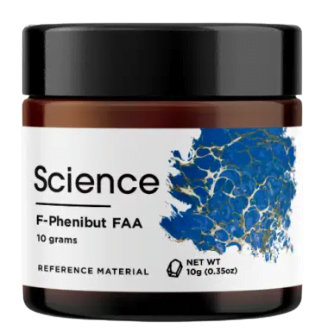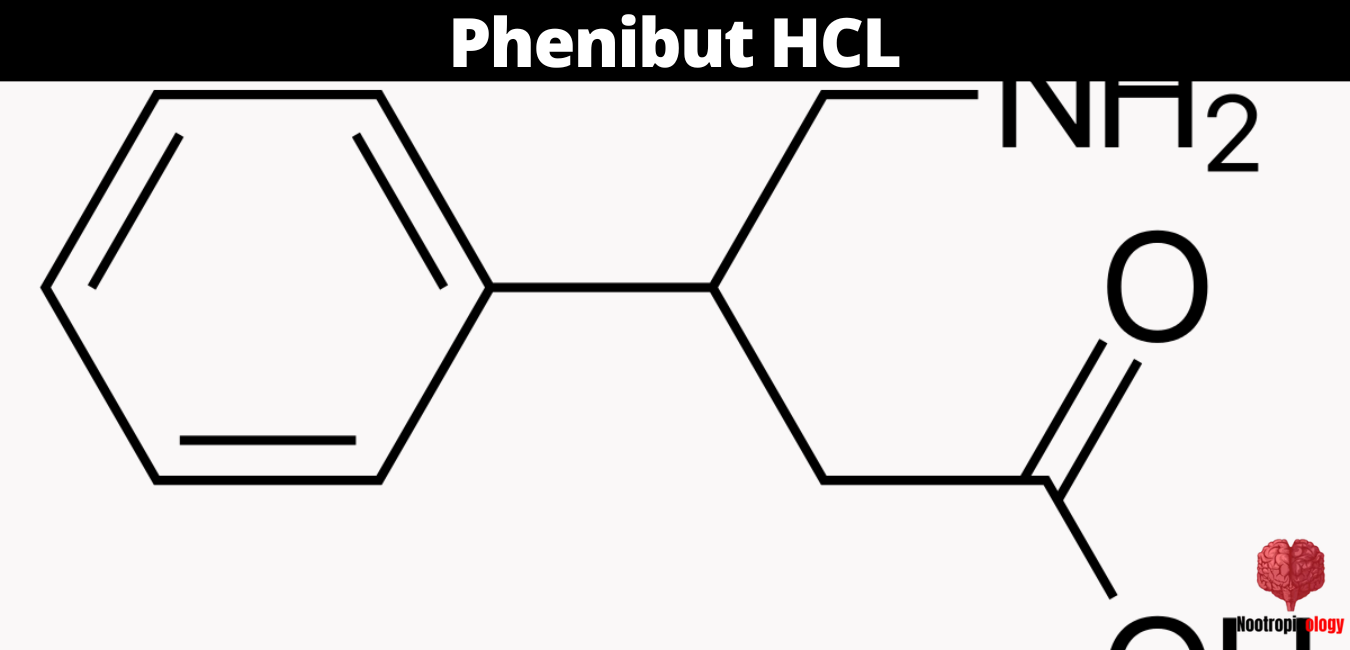
Phenibut (β-Phenyl-γ-aminobutyric acid hydrochloride) is a central nervous system (CNS) depressant with a unique profile of pharmacological effects. Developed in Russia, it has been employed in clinical settings to treat conditions like anxiety, insomnia, and other neurological disturbances.
Its primary mechanism of action involves mimicking the neurotransmitter γ-aminobutyric acid (GABA) and binding to GABA_B receptors in the brain, resulting in potential sedative, anxiolytic, and muscle relaxant outcomes. Phenibut has therapeutic applications, with the potential for misuse. Over-the-counter availability and uncontrolled intake can lead to abuse, dependence, and subsequent withdrawal symptoms.
Phenibut FAA

Phenibut HCL, scientifically known as β-Phenyl-γ-aminobutyric acid HCl, is a neuropsychotropic substance that traces its origins to Russia in the 1960s, where it was discovered and subsequently integrated into clinical practice. Its primary effects are anxiolytic (anxiety-reducing) and nootropic (cognition-enhancing). At its core, Phenibut functions as a GABA-mimetic, predominantly interacting with GABAB receptors and to a lesser extent, GABAA receptors.
| Category | Information |
|---|---|
| Trade names | Anvifen, Fenibut, Noofen, R-phenibut, others |
| Other names | Aminophenylbutyric acid; Fenibut; Fenigam; Phenigam; Phenybut; Phenygam; Phenylgamma; Phenigama; PHG; PhGABA; β-Phenyl-γ-aminobutyric acid; β-Phenyl-GABA |
| Routes of administration | Common: Oral · Uncommon: Rectal |
| Drug class | GABA receptor agonist; Gabapentinoid |
| ATC code | N06BX22 (WHO) |
| Legal status | S4 (Prescription only) · Class B1 (Psychoactive drugs) · : Unscheduled · : NpSG (Industrial and scientific use only) · Unscheduled (Unapproved "New Drug") as defined by 21 U.S. Code § 321(p)(1)). Use in dietary supplements, food, or medicine is unlawful; legal for research and medical uses as a research chemical. · Illegal in Alabama (schedule II) · Unscheduled · : Rx-only |
| Bioavailability | Well-absorbed · ≥63% (250 mg) |
| Metabolism | Liver (minimal) |
Phenibut HCL stimulates dopamine receptors and acts as an antagonist to a-phenethylamine (PEA), which is an endogenous compound contributing to anxiety. The psychopharmacological activity of Phenibut HCL mirrors that of baclofen, which is a p-Cl-derivative of Phenibut. Diving deeper into its structure-activity relationship, there are pivotal aspects worth noting:
Comparatively, when placed alongside drugs such as piracetam and diazepam, Phenibut showcases a unique blend of similarities and differences, both in its pharmacological mechanisms and clinical applications.
Phenibut FAA
Phenibut HCL has been utilized extensively in Russia for various therapeutic purposes. It helps alleviate symptoms of tension, anxiety, and fear and serves as a potent aid in enhancing sleep quality in patients battling psychosomatic or neurotic disorders.
It's employed as a pre-operative or post-operative medication. Beyond these, Phenibut has therapeutic implications in treating conditions characterized by feelings of asthenia (weakness) and depression. It also finds its use in the management of post-traumatic stress, stuttering, and vestibular (balance-related) disorders. [1]
Phenibut HCL was synthesized by Perekalin and colleagues at the Department of Organic Chemistry, Herzen Pedagogic Institute, St. Petersburg, Russia. In its early documentation, Phenibut was referred to as phenigamma.
The drug's pharmacological attributes were assessed by Khaunina and her team. Studies on the in vitro neuronal impacts of PB and its related GABA derivatives were conducted on isolated cat cerebral neurons. By 1964, the first comprehensive review on the pharmacology of PB and its related compounds had been published.
The pharmacological properties of PB, specifically its interactions with GABAA, GABAB, dopaminergic, and benzodiazepine (BDZ) receptors, were analyzed and juxtaposed with those of diazepam (DZP) and piracetam (PIR). A study led by Kovalev evaluated PB's effects on central regulation of circulation.
When administered systemically, Phenibut HCL offers a myriad of effects on our central system. It isn't just a one-trick pony; its influence spans various domains of neural activity:
While Phenibut HCL doesn't antagonize convulsions from various inducers, it does show some efficacy against specific conditions:
Phenibut HCL's nootropic (cognition-enhancing) abilities are intriguing:
Phenibut's effects aren't just biochemical; they extend to electrical activities within the brain:
Phenibut HCL offers a vast range of neuropsychopharmacological effects, which have made it an intriguing compound for both research and therapeutic applications.
Phenibut HCL has been acknowledged for its GABA-mimetic action, signifying that it mimics the effects of GABA (gamma-aminobutyric acid), a major inhibitory neurotransmitter in the brain.
Here are the summarized mechanisms regarding the central action of Phenibut:
GABA-Mimetic Action:
Dopaminergic Activation:
Antagonism of β-phenethylamine (PEA):
These mechanisms collectively contribute to the central action of Phenibut, which manifests in its anxiolytic, nootropic (cognition-enhancing), and tranquilizing effects.
According to a case study by Sahagian et al., from the Journal of Veterinary Emergency and Critical Care, published on July 12, 2023, a 2-year-old neutered male Weimaraner dog exhibited severe neurological and cardiovascular abnormalities post ingestion of Phenibut (HCL). [5]
Following the ingestion of approximately 1600 mg/kg of Phenibut, the dog was found unresponsive and laterally recumbent in its urine. The study primarily focused on describing the successful treatment of the aforementioned abnormalities in the dog following Phenibut ingestion.
A comprehensive systematic literature review titled "Clinical Presentations and Treatment of Phenibut Toxicity and Withdrawal" conducted by Jeremy Weleff et al., and published in the Journal of Addiction Medicine in 2023, shed light on the clinical presentations and treatment approaches for Phenibut toxicity.
The review encompassed 62 cases from 36 studies on Phenibut toxicity or withdrawal. During the instances of Phenibut toxicity, the most commonly reported symptoms included altered mental status, somnolence, psychosis, and movement disorders. Moreover, 48.7% of the Phenibut toxicity cases necessitated intubation.
The treatment predominantly involved the utilization of Benzodiazepines and antipsychotics. In cases of Phenibut withdrawal, symptoms such as anxiety, irritability or agitation, insomnia, and psychosis were prevalently reported. The treatment for withdrawal cases often entailed the use of multiple medications including Benzodiazepines, Baclofen, atypical antipsychotics, gabapentanoids, and barbiturates. [6]
These studies provide a detailed insight into the pharmacokinetics and toxicological profile of Phenibut, demonstrating the imperative need for structured treatment protocols, especially given the potential severity of Phenibut toxicity.
According to Lapin et al, Phenibut HCL demonstrates a range of positive effects spanning from tranquilizing to neuroprotective activities:
Below are the common and potentially serious side effects associated with Phenibut HCL:
Common Side Effects:
Serious Side Effects:
Other Considerations
The side effects of Phenibut HCL can range from mild to severe, and the risk may increase with higher doses or prolonged use. It's crucial for individuals to adhere to recommended dosages and to be under the supervision of a healthcare provider when using Phenibut HCL, particularly given its potential for dependency and the serious side effects associated with overdose.
According to a study published in Clinical Toxicology (Phila) in April 2022 by Pieter A Cohen et al., they found that Phenibut, has varying quantities in dietary supplements, especially in the United States where it's available over-the-counter despite not being approved by the FDA as a prescription medication. [7]
The study aimed to analyze the presence and quantity of Phenibut in dietary supplements before and after FDA warnings regarding its use. In the study, four brands of dietary supplements labeled as containing Phenibut were examined. Before the FDA warnings, two of the four brands contained Phenibut, with dosages of 484 mg and 487 mg per serving.
Post the FDA warnings, all four products were found to contain Phenibut, with dosages ranging from 21 mg to 1,164 mg per serving. It was also observed that the quantity of Phenibut increased in three of the four products after the FDA warnings, with quantities per dose being as much as 450% greater than a typical 250 mg pharmaceutical tablet manufactured in Russia.
The dosage of Phenibut HCL for nootropic stacking and cognitive enhancement varies and should be approached with caution due to the substance's potential for tolerance and addiction. Here are the guidelines from different sources:
Starting Dosage:
Dosage Range:
Maximum Dosage:
Frequency:
Nootropic Stacking:
Dosage Adjustments:
These dosage guidelines and stacking suggestions should serve as a starting point, but individuals should consult healthcare professionals before using Phenibut HCL, especially given its potential for tolerance and addiction.
In healthy individuals, Phenibut HCL may improve focus, reduce anxiety, and enhance overall mental clarity. Its anxiolytic properties can lead to improved social interactions and reduced performance anxiety, potentially boosting cognitive function in stressful situations.
User experiences with Phenibut HCL vary widely, reflecting its complex effects on the brain and body. Many users report positive outcomes, particularly in social situations and for managing anxiety. However, it's crucial to approach these anecdotal reports with caution, as individual responses can differ significantly.
Reddit discussions about Phenibut HCL reveal a mix of experiences. Many users praise its ability to reduce social anxiety and improve mood. Some report enhanced cognitive function and increased motivation. However, concerns about tolerance, dependence, and withdrawal are frequently mentioned. Users often emphasize the importance of responsible use and adhering to recommended dosages.
Upon starting my journey with Phenibut HCL, I began with a low dosage of 250 mg to assess my tolerance. The first few days were marked by a subtle increase in calmness and a reduction in anxiety levels. I gradually increased my dosage to 500 mg, which I found to be more effective in enhancing my mood and social interactions.
The most noticeable effects of Phenibut included:
Despite the positive effects, I also encountered some side effects:
In summary, my experience with Phenibut HCL was largely positive, providing notable benefits in anxiety reduction, sleep improvement, and enhanced focus. However, I learned the importance of moderation and awareness of potential side effects. Responsible use, including cycling and careful dosage management, is crucial for maximizing benefits while minimizing risks.
Users typically describe the feeling of Phenibut HCL as a sense of calm euphoria and increased sociability. Many report reduced anxiety, improved sleep quality, and enhanced cognitive performance. Results often include better social interactions, reduced stress, and improved overall well-being. However, these effects can vary greatly between individuals, and some users report no noticeable effects at all.
Purchasing Phenibut HCL requires careful consideration of legal status and vendor reliability. In many countries, Phenibut HCL is unregulated and can be purchased online. However, its legal status varies globally, and it's crucial to check local regulations before purchasing.